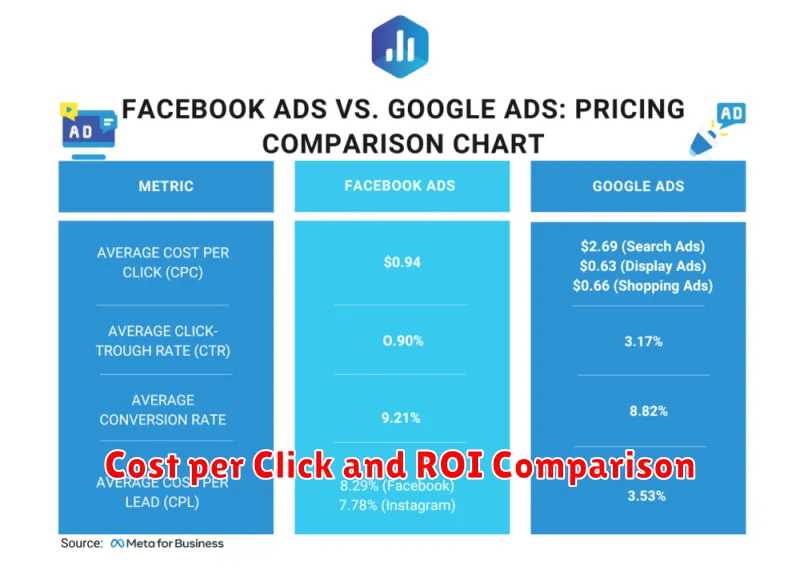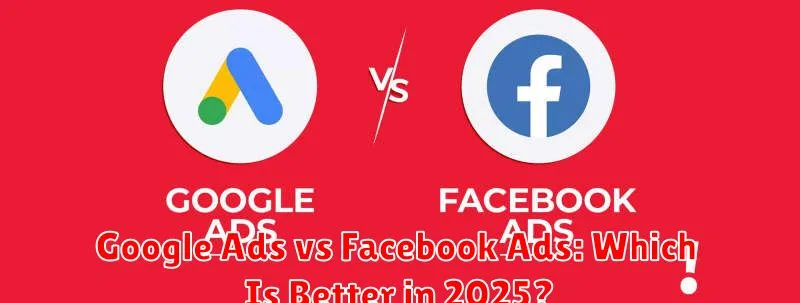Choosing the right advertising platform is crucial for business success in the ever-evolving digital landscape. In 2025, two giants continue to dominate the online advertising arena: Google Ads and Facebook Ads. This article delves into a comprehensive comparison of these two powerful platforms, exploring their strengths and weaknesses to help you determine which is better suited for your specific marketing objectives. We will dissect key factors such as targeting options, ad formats, cost-effectiveness, and overall return on investment (ROI) to provide you with the insights necessary to make an informed decision. Understanding the nuances of Google Ads vs. Facebook Ads is essential for maximizing your advertising budget and achieving your desired results in the competitive digital marketplace of 2025.
Navigating the complex world of online advertising can be challenging. This comparative analysis of Google Ads vs. Facebook Ads will equip you with the knowledge to choose the platform that aligns best with your business goals. Whether you are focused on driving website traffic, generating leads, increasing brand awareness, or boosting sales, understanding the distinct advantages of each platform is paramount. This article will examine the core functionalities of both Google Ads and Facebook Ads, considering factors such as audience reach, ad placement options, campaign management tools, and performance measurement metrics. By the end of this article, you will have a clearer understanding of which platform, Google Ads or Facebook Ads, offers the optimal solution for your specific advertising needs in 2025.
Understanding the Key Differences
While both platforms offer powerful advertising capabilities, Google Ads and Facebook Ads operate on fundamentally different principles. Google Ads excels at capturing user intent. People actively searching on Google are expressing a specific need, making it ideal for businesses seeking immediate conversions. Conversely, Facebook Ads focus on audience targeting. Advertisers can leverage demographic, interest-based, and behavioral data to reach potential customers who may not yet be aware of their need.
Understanding this core distinction is crucial for selecting the right platform for your specific marketing objectives.
Cost per Click and ROI Comparison

A key difference between Google Ads and Facebook Ads lies in their cost-per-click (CPC) and return on investment (ROI). Generally, Google Ads sees a higher average CPC due to its intent-based advertising model. Users actively search for specific products or services, making their clicks more valuable.
Facebook Ads, leveraging a more demographic and interest-based targeting approach, often boasts a lower CPC. However, ROI is more nuanced. While Facebook Ads can be highly effective for brand awareness and broader reach, Google Ads excels in driving conversions from users with immediate purchase intent. The “better” platform depends heavily on campaign objectives and target audience.
Audience Targeting Capabilities
Both platforms offer robust audience targeting. Google Ads excels with intent-based targeting, allowing advertisers to reach users actively searching for specific products or services. This includes keywords, demographics, and website behavior.
Facebook Ads focuses on connection-based targeting, leveraging user demographics, interests, behaviors, and connections. This allows for highly granular targeting based on user profiles and engagement.
Choosing the right platform depends on your campaign goals. For immediate conversions based on active searches, Google Ads may be more effective. For building brand awareness and engaging specific demographics, Facebook Ads might be a better fit.
Ad Format and Creative Flexibility
Both Google Ads and Facebook Ads offer diverse ad formats. Google Ads excels with text-based search ads, responsive display ads, and video ads on YouTube. Its strength lies in intent-based targeting.
Facebook Ads, however, shines with visually engaging formats like image and video ads, carousel ads, and Stories. It leverages its vast user data for detailed audience targeting based on demographics, interests, and behavior.
Best Use Cases for Each Platform
Google Ads excels when users actively search for specific products or services. It’s ideal for businesses aiming to capture immediate demand and drive conversions. Think e-commerce stores, local service providers, and businesses offering specialized solutions.
Facebook Ads thrives on connecting with users based on their interests, demographics, and behaviors. It’s best for businesses focused on brand awareness, building a community, and retargeting previous website visitors. Consider using Facebook Ads for product launches, promoting content, and reaching niche audiences.
Analytics and Conversion Tracking
Both Google Ads and Facebook Ads offer robust analytics and conversion tracking capabilities. Understanding these tools is crucial for optimizing campaigns and maximizing ROI.
Google Ads provides detailed data on keyword performance, search queries, and user demographics. Its conversion tracking allows you to measure actions users take after clicking your ads, such as purchases or form submissions.
Facebook Ads focuses on audience insights, engagement metrics, and website conversions. Its pixel tracks user behavior across your website and Facebook, enabling retargeting and performance analysis.
Ease of Use and Learning Curve
Both Google Ads and Facebook Ads present unique learning curves. Google Ads is often considered slightly more complex, focusing on keyword research and bidding strategies. Mastering its intricacies can take time and effort.
Facebook Ads, with its intuitive interface, is generally perceived as easier to navigate initially. However, effectively utilizing its targeting and audience creation options requires a different skillset. Ultimately, becoming proficient in either platform requires ongoing learning and adaptation.
Combining Both Platforms Effectively
Instead of viewing Google Ads and Facebook Ads as competing platforms, consider their synergistic potential.
Leverage Facebook’s detailed targeting to build brand awareness and generate initial interest. Then, retarget engaged users with highly specific Google Ads as they actively search for solutions. This approach maximizes the strengths of each platform, creating a powerful, full-funnel marketing strategy.
Budget Allocation Tips
Allocating your budget effectively across Google Ads and Facebook Ads depends heavily on your specific goals and target audience.
If you’re focused on driving immediate sales and reaching users actively searching for your products or services, allocate a larger portion to Google Ads.
For brand awareness and reaching a broader audience based on demographics and interests, prioritize Facebook Ads. Consider a 70/30 split favoring Google Ads for direct sales, or a 60/40 split favoring Facebook Ads for brand building, adjusting as you analyze campaign performance.
Which Platform Wins for Your Goals?
The “better” platform depends entirely on your specific objectives. Google Ads excels for targeting users actively searching for products or services like yours. This makes it ideal for driving conversions and capturing high-intent traffic.
Facebook Ads, however, thrives on its vast audience reach and detailed targeting options. This strength makes it a powerful tool for brand awareness, engagement, and retargeting campaigns. Consider your budget, target audience, and campaign goals to determine the right platform.

